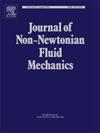Bingham flow development in annular tubes in the presence of wall slip
IF 2.7
2区 工程技术
Q2 MECHANICS
引用次数: 0
Abstract
The development of Bingham flow in concentric annular tubes in the presence of wall slip is investigated. It is assumed that slip occurs along both cylinders, following Navier's law, which states that the slip velocity is proportional to the wall shear stress. The open-source finite element software FEniCS is used for the numerical simulations along with the Papanastasiou regularization for the constitutive equation. To correctly determine the entrance region, various definitions of the development length are considered. In addition to the standard definition, which is based on the maximum velocity development, and the global development length, alternative definitions based on the development of the wall shear stresses and of the velocity at the two yield radii are considered. The combined effects of slip, yield stress and inertia on the different development lengths are systematically investigated. The yielded and unyielded zones are also determined using the von Mises criterion. The numerical results show that the standard development length fails to accurately capture the entrance region, even in the case of Newtonian flow with no-slip, and that the inner wall shear stress and yield lengths are also inadequate. The global and the outer wall shear stress and yield development lengths, which can be up to four times bigger than the standard development length, are more reliable. In agreement with previous studies, the development lengths are monotonically increasing with the Reynolds and Bingham numbers. As wall slip becomes stronger these reliable development lengths increase only initially reaching a maximum and then they are abruptly reduced to zero as the slip number approaches the critical value corresponding to sliding (unyielded) motion.
存在壁面滑移的环空管内Bingham流动发展
研究了存在壁面滑移时同心环管内宾厄姆流动的发展。假设沿两个圆柱体都发生滑移,遵循纳维尔定律,即滑移速度与壁面剪切应力成正比。采用开源有限元软件FEniCS进行数值模拟,并对本构方程进行Papanastasiou正则化。为了正确确定入口区域,考虑了发展长度的各种定义。除了基于最大速度发展和整体发展长度的标准定义外,还考虑了基于壁面剪应力发展和两个屈服半径处速度发展的替代定义。系统地研究了滑移、屈服应力和惯性对不同发育长度的综合影响。利用von Mises准则也确定了屈服区和未屈服区。数值计算结果表明,即使在无滑移的牛顿流条件下,标准发育长度也不能准确地捕捉入口区域,并且内壁剪应力和屈服长度也不充分。整体和外壁剪应力和屈服发展长度可达标准发展长度的4倍,更加可靠。与以往的研究一致,发展长度随Reynolds数和Bingham数单调增加。当壁面滑动变得更强时,这些可靠的发展长度只在最初达到最大值时增加,然后随着滑动数接近与滑动(未屈服)运动相对应的临界值,它们突然减少到零。
本文章由计算机程序翻译,如有差异,请以英文原文为准。
求助全文
约1分钟内获得全文
求助全文
来源期刊
CiteScore
5.00
自引率
19.40%
发文量
109
审稿时长
61 days
期刊介绍:
The Journal of Non-Newtonian Fluid Mechanics publishes research on flowing soft matter systems. Submissions in all areas of flowing complex fluids are welcomed, including polymer melts and solutions, suspensions, colloids, surfactant solutions, biological fluids, gels, liquid crystals and granular materials. Flow problems relevant to microfluidics, lab-on-a-chip, nanofluidics, biological flows, geophysical flows, industrial processes and other applications are of interest.
Subjects considered suitable for the journal include the following (not necessarily in order of importance):
Theoretical, computational and experimental studies of naturally or technologically relevant flow problems where the non-Newtonian nature of the fluid is important in determining the character of the flow. We seek in particular studies that lend mechanistic insight into flow behavior in complex fluids or highlight flow phenomena unique to complex fluids. Examples include
Instabilities, unsteady and turbulent or chaotic flow characteristics in non-Newtonian fluids,
Multiphase flows involving complex fluids,
Problems involving transport phenomena such as heat and mass transfer and mixing, to the extent that the non-Newtonian flow behavior is central to the transport phenomena,
Novel flow situations that suggest the need for further theoretical study,
Practical situations of flow that are in need of systematic theoretical and experimental research. Such issues and developments commonly arise, for example, in the polymer processing, petroleum, pharmaceutical, biomedical and consumer product industries.

 求助内容:
求助内容: 应助结果提醒方式:
应助结果提醒方式:


